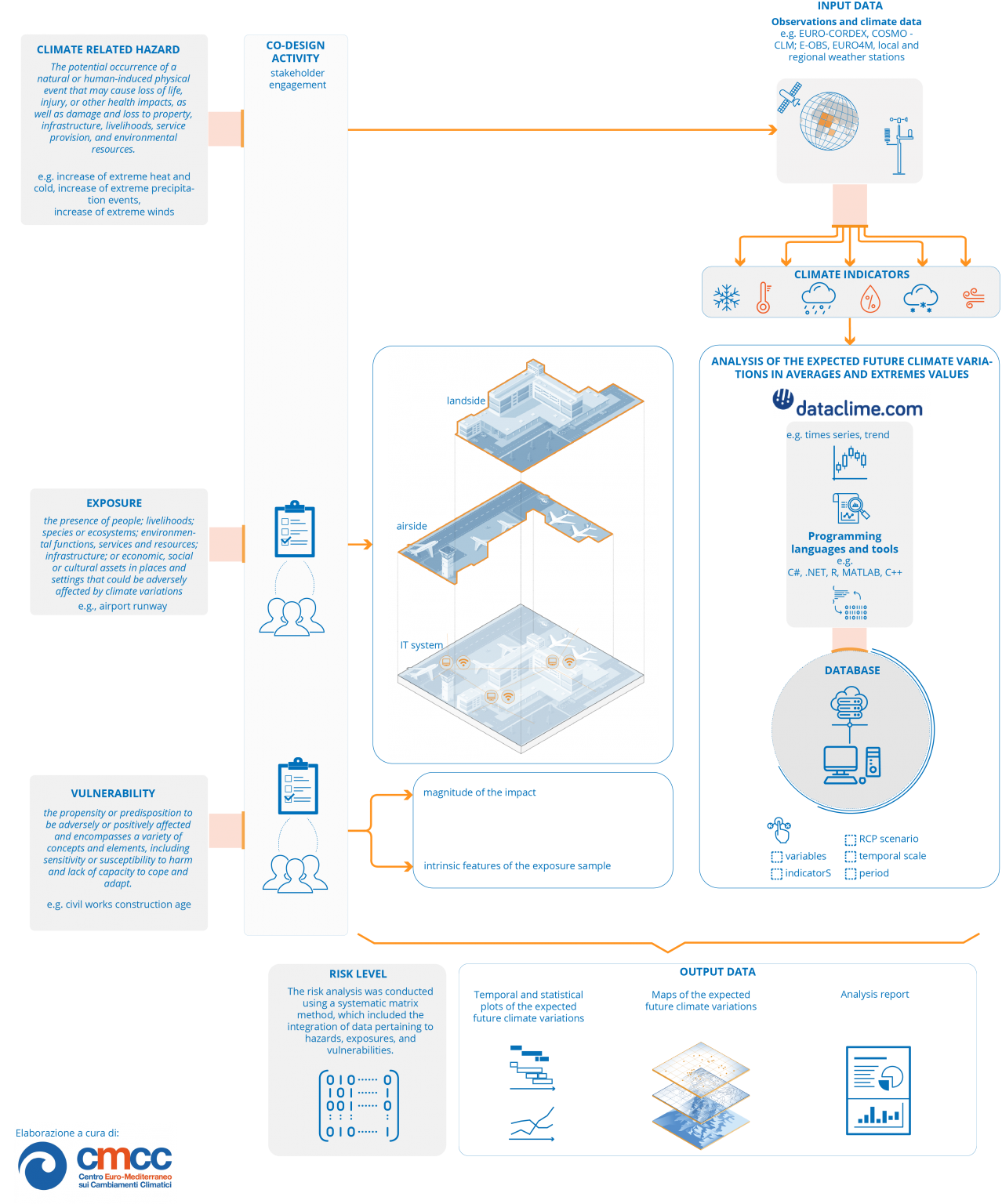Aeroporto Guglielmo Marconi di Bologna S.p.A.:
Analysis of vulnerabilities and risks arising from the impacts of climate change
Goals
The project “Analysis of vulnerabilities and risks arising from the impacts of climate change on Guglielmo Marconi Airport in Bologna S.p.A.” focused on the development of a risk analysis on Bologna Airport for different climate hazards, with the aim of supporting the identification of specific adaptation strategies for the most vulnerable assets to climate change.
Carried out activities
The carried out activities have focused on:
- The hazard assessment(current and expected climate) was analyzed through a wide range of climate indicators considered representative of specific climate hazards that have occurred and could potentially lead to losses and damages at the airport (i.e., increased of extreme temperature events, increased of extreme precipitation events, increased of extreme wind events). These hazards were identified through a co-design process, involving a series of exchange meetings with key stakeholders of the airport.
- The exposure assessment was also developed by adopting a co-design approach involving airport operators. Using this approach, all elements of the airport system that could be most threatened by climate hazards were identified. After reviewing the most recent scientific literature and discussing with airport managers, the airport elements were divided into three main categories:
- (a) airside: it includes elements dedicated to aircraft movement, such as runways, taxiways, control tower and apron;
- (b) landside: referring to public access areas such as offices, terminals, airport access systems, and parking areas;
- (c) airport information systems: this category includes IT infrastructure, such as servers and tools that manage the operation of all airport services, both airside and land side activities.
- The vulnerability assessment refers to the predisposition of the system to be adversely affected by climate change. For this phase of analysis, the stakeholders of Guglielmo Marconi Airport S.p.A. were actively involved through the compilation of two specific questionnaires in order to identify the vulnerability characteristics of the exposed samples, promoting an inclusive and participatory approach. The first questionnaire was used to assess the severity of the impact on each element exposed according to the climate hazard considered. The second questionnaire was useful in collecting information on the intrinsic characteristics of the exposed samples, which make them more or less vulnerable to the impacts of climate change.
- The risk analysis was conducted through a matrix-based approach, integrating information on the hazard, exposure, and vulnerability of the airport. The matrix-based approach is particularly useful because it actively involves experts and key stakeholders of the airport who possess in-depth knowledge of the system and its vulnerabilities. This involvement occurs through a co-design process, ensuring an accurate and inclusive assessment of climate risks throughout the evaluation process.

Dataclime functionalities
Dataclime platform gives the possibility to view and download all the hazard maps (3 different scenarios IPCC considered – RCP2.6, RCP4.5, RCP8.5, time period analysed – 2032-2061) of the different hazard indicators concerning temperature, precipitation and wind defined in the hazard assessment phase.
Reference
De Vivo, C., Barbato, G., Ellena, M., Capozzi, V., Budillon, G., & Mercogliano, P. (2023). Application of climate risk assessment framework for selected Italian airports: A focus on extreme temperature events. Climate Services, 30, 100390.
De Vivo, C., Barbato, G., Ellena, M., Capozzi, V., Budillon, G., & Mercogliano, P. (2023). Climate-Risk Assessment Framework for Airports under Extreme Precipitation Events: Application to Selected Italian Case Studies. Sustainability, 15(9), 7300.
De Vivo, C., Ellena, M., Capozzi, V., Budillon, G., & Mercogliano, P. (2021). Risk assessment framework for Mediterranean airports: A focus on extreme temperatures and precipitations and sea level rise. Natural Hazards, 1-20.
Forzieri, G., Bianchi, A., e Silva, F. B., Herrera, M. A. M., Leblois, A., Lavalle, C., … & Feyen, L. (2018). Escalating impacts of climate extremes on critical infrastructures in Europe. Global environmental change, 48, 97-107.
Internation Civil Aviation Organitation (ICAO) (2022) Climate Resilience Airports
Lopez, A. (2016). Vulnerability of airports on climate change: an assessment methodology. Transportation Research Procedia, 14, 24-31.

